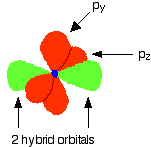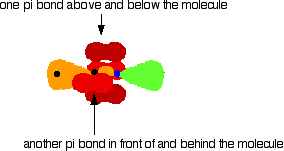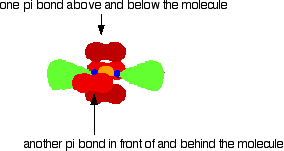|
Chemguide: Support for CIE A level Chemistry Learning outcome 3.4.2 Covalent bonding - σ (sigma) and π (pi) bonds This statement explains what σ (sigma) and π (pi) bonds are and introduces the concept of hybridisation. Learning outcomes 3.4.2(a), 3.4.2(b) and 3.4.2(c) I am taking these together because they are covered in the same set of Chemguide pages. The concept of hybridisation which you will meet in this topic isn't really very difficult, but you need to take your time over it. Before you go on, you should find and read the statements in your copy of the syllabus. The formation of sigma bonds First, you should read the page which looks at bonding in methane and ethane. This page (and the next three that you will find below) come from the organic chemistry part of Chemguide. If you have already read the whole of the covalent bonding page referred to in learning outcome 3.4.1, you will recognise the bit about methane. Don't go on to ethene (next link below) until you are sure that you understand about the formation of methane and ethane. The syllabus also mentions the formation of a sigma bond in H2. This is completely trivial. When a hydrogen molecule is formed, the 1s1 orbitals from the two hydrogen atoms overlap to form a new molecular orbital. No hybridisation is involved. Because it is a simple overlap, what is formed is a sigma bond. The formation of pi bonds in double bonds Now read the page about bonding in ethene. By the time you have finished this page, it is really important that you understand the difference between a sigma bond (formed by end-to-end overlap between atomic orbitals) and a pi bond (formed by sideways overlap). Don't go on to ethyne (below) until you are sure that you understand ethene. The formation of pi bonds in triple bonds Now go on to look at the formation of sp hybrid orbitals by reading the page about bonding in ethyne. The bonding in ethyne (acetylene) isn't required by the syllabus, but is really useful to understand it because it helps you to work out the bonding in two molecules in statement 3.4.2(b) which I haven't discussed anywhere on Chemguide - HCN and N2. HCN You may need to keep referring back to the ethyne page during what follows. Nitrogen has the electronic structure 1s22s22px12py12pz1. It has one more electron than carbon. Putting the outer electrons in boxes, you have
Just like the carbon atoms in ethyne, this hybridises to give two sp1 hybrids, leaving two of the p orbitals unchanged.
Unlike the carbons in ethyne, one of the hybrid orbitals contains a lone pair of electrons. | |
|
Note: Two points: To maintain consistency with the other sorts of hybridisation, I prefer the older term sp1 hybrids. The syllabus simply talks about sp hybrides. I can't honestly see this mattering, but if in doubt in an exam, follow the syllabus! Notice this is still called sp (or sp1) hybridisation even though one of the orbitals contains 2 electrons. You are counting the number of orbitals hybridised, not the number of electrons. | |
|
So the diagam you last saw on the ethyne page, only differs because one of the green hybrid orbitals (say the right-hand one) contains a lone pair and won't take any further part in the bonding.
That nitrogen is now going to join to a carbon with a hydrogen attached - basically the left-hand side of the ethyne molecule you will have read about, giving HCN. You will get a sigma bond on the line between the two nuclei, and two pi bonds formed by sideways overlap between p orbitals on the carbon and nitrogen. Look back to the ethyne page if you need to.
This is just a modified form of the ethyne diagram. The only difference, apart from the fact that the right-hand nucleus has turned blue, is that at the nitrogen end of the molecule, you have a lone pair of electrons in the hybrid orbital rather than it being attached to a hydrogen. Nitrogen, N2 In HCN we replaced the C-H at one end of the molecule by a nitrogen atom and a lone pair. It made no difference to the triple bond in the centre of the molecule. What if we replaced the other H-C group by a nitrogen as well? What you get is a molecule of N2 which looks like this:
You have the two nitrogens joined by exactly the same arrangement of orbitals as in ethyne and HCN, but this time there is a lone pair of electrons at each end of the molecule. Any triple bond will be made of a sigma bond and two pi bonds at right angles to each other. The structure of benzene The structure of benzene, which involves sp2 hybridisation, isn't required until the second half of the A level course. But if I was teaching it, I would want to include the benzene case to follow logically on from ethene, even though benzene won't be examined at AS. Alternatively, you could leave this for now, and come back to it again later when it is more directly relevant to the chemistry of benzene. This statement is repeated at the beginning of the organic section of the syllabus, but not specifically when the chemistry of benzene is introduced. However, I will point it out to you at the time. It wouldn't hurt to read this now and re-read it later on. The page you want is bonding in benzene.
If you are going to read it, don't bother about anything other than the formation of the bonds for now.
© Jim Clark 2019 |
|




